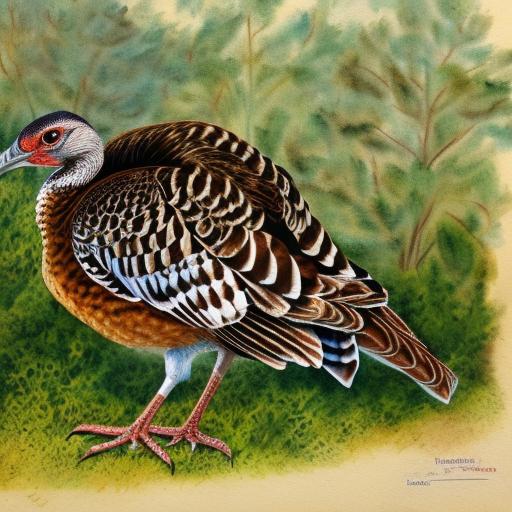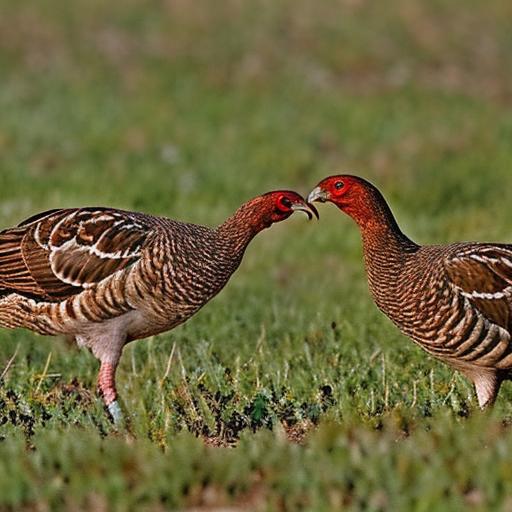Wild turkeys are large birds native to North America and are a popular game bird for hunters. They are known for their distinctive fan-shaped tails and wattled necks. There are five subspecies of wild turkeys, each with its own unique characteristics and habitat. These subspecies include the Eastern wild turkey, Osceola wild turkey, Rio Grande wild turkey, Merriam’s wild turkey, and Gould’s wild turkey. Each subspecies has its own range and specific traits that make it distinct from the others. Wild turkeys are known for their elusive nature and keen senses, making them a challenging and rewarding target for hunters.
Key Takeaways
- Wild turkeys are native to North America and are known for their large size and distinctive plumage.
- The Eastern wild turkey is the most widespread and populous subspecies, found in the eastern United States and parts of Canada.
- The Osceola wild turkey is found in Florida and is known for its smaller size and darker plumage.
- The Rio Grande wild turkey is found in the central plains and western regions of the United States.
- The Merriam’s wild turkey is found in the mountainous regions of the western United States and is known for its light-colored plumage.
Eastern Wild Turkey
The Eastern wild turkey (Meleagris gallopavo silvestris) is the most widespread subspecies of wild turkey and can be found in the eastern United States and parts of Canada. They are known for their dark, iridescent plumage and can weigh up to 24 pounds. Eastern wild turkeys prefer hardwood forests and mixed woodlands, where they can find a variety of food sources such as acorns, nuts, seeds, and insects. They are also known to inhabit agricultural areas and open fields. Eastern wild turkeys are social birds and often form flocks, especially during the winter months. They are also known for their distinctive gobbling calls, which they use to communicate with other turkeys.
Osceola Wild Turkey
The Osceola wild turkey (Meleagris gallopavo osceola) is found exclusively in the state of Florida and is known for its smaller size and darker plumage compared to other subspecies. They can weigh up to 17 pounds and have a more limited range compared to other subspecies. Osceola wild turkeys prefer the dense, swampy habitats of the Florida peninsula, where they can find suitable roosting sites and food sources such as berries, seeds, and insects. They are also known for their wary nature and are often difficult to hunt due to their keen senses and ability to quickly disappear into the dense vegetation of their habitat. The Osceola wild turkey is highly sought after by hunters due to its limited range and unique characteristics.
Rio Grande Wild Turkey
The Rio Grande wild turkey (Meleagris gallopavo intermedia) is found in the central plains of the United States, including Texas, Oklahoma, Kansas, and parts of New Mexico and Colorado. They are known for their lighter plumage and can weigh up to 25 pounds. Rio Grande wild turkeys prefer open woodlands, brushy areas, and grasslands where they can find a variety of food sources such as seeds, insects, and small reptiles. They are also known for their adaptability to different habitats and are often found in agricultural areas and along river bottoms. Rio Grande wild turkeys are social birds and often form large flocks, especially during the winter months. They are also known for their distinctive gobbling calls, which they use to communicate with other turkeys.
Merriam’s Wild Turkey
Merriam’s wild turkey (Meleagris gallopavo merriami) is found in the mountainous regions of the western United States, including parts of Montana, Wyoming, South Dakota, Nebraska, and New Mexico. They are known for their lighter plumage with white tips on their tail feathers and can weigh up to 18 pounds. Merriam’s wild turkeys prefer coniferous forests, pine woodlands, and mountainous terrain where they can find a variety of food sources such as berries, seeds, and insects. They are also known for their elusive nature and are often found in remote and rugged landscapes. Merriam’s wild turkeys are social birds and often form small flocks, especially during the winter months. They are also known for their distinctive gobbling calls, which they use to communicate with other turkeys.
Habitat and Behavior of Wild Turkeys

Wild turkeys are highly adaptable birds that can be found in a variety of habitats across North America, including forests, woodlands, grasslands, swamps, and agricultural areas. They are omnivorous birds that feed on a variety of food sources such as acorns, nuts, seeds, berries, insects, small reptiles, and amphibians. Wild turkeys are social birds that often form flocks, especially during the winter months when food sources may be scarce. They are also known for their keen senses of sight and hearing, which make them wary and elusive prey for hunters.
Wild turkeys have a complex social structure and communicate with each other using a variety of vocalizations, including gobbling calls, clucks, putts, yelps, and purrs. These vocalizations are used to establish dominance within the flock, attract mates during the breeding season, and alert other turkeys to potential dangers. Wild turkeys are also known for their elaborate courtship displays, which involve strutting, puffing out their feathers, and fanning their tails to attract mates.
Conservation Efforts for Wild Turkey Populations
Wild turkeys were once on the brink of extinction due to overhunting and habitat loss, but thanks to conservation efforts, their populations have made a remarkable recovery. Conservation organizations such as the National Wild Turkey Federation (NWTF) have played a crucial role in restoring wild turkey populations through habitat restoration, predator management, and sustainable hunting practices.
Habitat restoration efforts have focused on creating suitable habitat for wild turkeys by planting native vegetation, restoring wetlands, and managing forests to provide food sources and roosting sites. Predator management has involved controlling populations of predators such as raccoons, opossums, and coyotes that can prey on wild turkey eggs and poults. Sustainable hunting practices have involved implementing regulations such as bag limits and hunting seasons to ensure that wild turkey populations remain healthy and stable.
In addition to these efforts, education and outreach programs have helped raise awareness about the importance of conserving wild turkey populations and their habitats. These programs have encouraged landowners to implement wildlife-friendly practices on their properties and have promoted responsible hunting practices among hunters.
Overall, conservation efforts have been successful in restoring wild turkey populations across North America, ensuring that future generations will be able to enjoy these iconic birds for years to come.
Sure, here’s a paragraph mentioning a related article to wild turkeys:
If you’re interested in raising poultry, you might also want to learn about the different breeds of wild turkeys. Understanding the characteristics and behaviors of breeds like the Eastern, Osceola, Rio Grande, and Merriam’s turkeys can be fascinating for poultry enthusiasts. For more information on raising and caring for poultry, check out this helpful article on how many chickens you need for a family of 4.
FAQs
What are the four breeds of wild turkeys?
The four breeds of wild turkeys are the Eastern wild turkey, the Osceola wild turkey, the Rio Grande wild turkey, and the Merriam’s wild turkey.
Where can the Eastern wild turkey be found?
The Eastern wild turkey can be found in the eastern United States and parts of Canada.
Where can the Osceola wild turkey be found?
The Osceola wild turkey can be found in Florida.
Where can the Rio Grande wild turkey be found?
The Rio Grande wild turkey can be found in the central and western United States, primarily in Texas, Oklahoma, Kansas, and parts of Mexico.
Where can the Merriam’s wild turkey be found?
The Merriam’s wild turkey can be found in the western United States, primarily in the Rocky Mountains and parts of the Great Plains.
Meet Walter, the feathered-friend fanatic of Florida! Nestled in the sunshine state, Walter struts through life with his feathered companions, clucking his way to happiness. With a coop that’s fancier than a five-star hotel, he’s the Don Juan of the chicken world. When he’s not teaching his hens to do the cha-cha, you’ll find him in a heated debate with his prized rooster, Sir Clucks-a-Lot. Walter’s poultry passion is no yolk; he’s the sunny-side-up guy you never knew you needed in your flock of friends!







